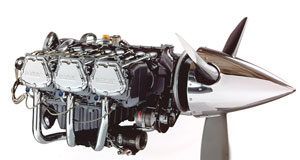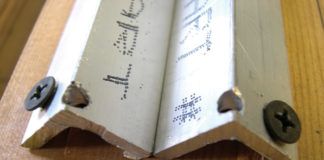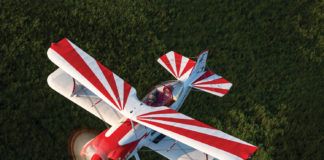Last month we took a look at the basics of lateral stability and the dihedral effect. We now turn our attention to how the airplane responds in roll when the pilot maneuvers it.
The roll flying qualities of an airplane have a large effect on how pleasant it is to fly, particularly for sport aircraft. An airplane with heavy roll control forces and/or sluggish roll response may be a good IFR platform, but not fun to fly. The pilot will see the airplane as difficult to maneuver and find the effort required to roll the airplane into and out of turns excessive. On the other hand, an airplane with excessively light roll forces, particularly if they are combined with fast roll response, will feel twitchy and be prone to lateral pilot-induced oscillation (PIO). Roll Response
The proper roll response varies with the mission of the airplane. An aerobatic airplane or a fighter should have fast roll response and low roll stick forces. A long-range, cross-country airplane with this combination would prove to be tiring to fly in turbulence or IFR conditions, as the pilot would have to pay continual attention to keeping the wings level.
Two basic characteristics are important when considering the roll response of an airplane. The first is the roll acceleration, and the second is the steady-state roll rate. Both of these will contribute to the pilots perception of the airplanes flying qualities.
Roll acceleration is the rate at which the ailerons can change the planes roll rate. The pilots initial sense of whether the airplane is crisp or sluggish in roll will be determined more by the roll acceleration than the roll rate. Poor roll acceleration can be annoying, because the pilot perceives it as a roll-control lag. Lag in roll response, particularly if combined with high roll rates after the lag, can trigger lateral PIO.
When the pilot deflects the ailerons, the airplane starts to roll. As roll rate rises, roll acceleration drops, and eventually the roll rate reaches a constant value. The maximum steady-state roll rate is the rate at which the bank angle of the airplane changes with fully deflected ailerons, once the roll rate has built to its full value. The time it takes for the airplane to reach its maximum steady-state roll rate is determined by the roll acceleration the ailerons can produce. Roll-rate capability is important in maneuvers that require a large change in bank angle, such as bank-to-bank reversals, rapid entry into steep turns and aerobatic rolling maneuvers. Hesitation rolls make high demands on both roll acceleration and roll rate. At each point of the roll, the pilot must stop the roll rate momentarily and then quickly bring it back to a high value.
A less exciting maneuver that is often used to evaluate roll performance is a bank-to-bank reversal. In this maneuver, the airplane is placed in a steady turn with a given bank angle. The ailerons are then deflected to roll the airplane into an equally banked turn in the opposite direction. The maneuver is timed, and both the military and the FAA have specifications for the minimum acceptable bank-to-bank times for various classes of airplanes. The FAA specifications for light airplane roll performance can be found in FAR Part 23.
The roll characteristics of an airplane are determined by a combination of many factors including the control power of the roll-control surfaces, the roll damping of the airplane and the roll inertia of the airplane. Control Power
When the airplane is flying straight and level, the roll rate and the roll acceleration are both zero. If the pilot deflects the ailerons, they cause the lift of one wing to increase and the other to decrease. The difference in lift between the two wings causes a moment or torque about the centerline called the rolling moment. The greater the lift difference between the wings, the greater the roll acceleration and the maximum roll rate will be. How much roll-control power the airplane needs is determined primarily by the mission of the airplane. It is also strongly a function of the roll inertia of the airplane and the bank-to-bank time it must achieve.
The amount of roll-control power available is determined by the amount of lift change a deflected aileron can produce and the moment arm from the c.g. it has to act upon. The further outboard the aileron-induced lift acts, the more rolling moment it can create. It is therefore desirable to place the ailerons as far outboard on the wing as possible. In a few special cases, such as the VariEze and Long-EZ, they are moved inboard, but this is for mechanical convenience in the aileron control linkages.
The amount of lift change the ailerons can produce is determined by their size and geometry. Increasing the size of an aileron increases its control power, but as the aileron chord gets larger than 30% to 35% of the wing chord, the increase in effectiveness gained drops off, and the hinge moments get larger rapidly.
Increasing aileron area by increasing the span may also increase control power, particularly if the ailerons are small to begin with. The drawback is that increasing aileron span adds aileron area relatively far inboard on the wing where it has a small moment arm to work on to produce rolling moment. Many aerobatic airplanes, which need all the roll control power they can get, have large-chord, full-span ailerons.
The deflection of the ailerons also helps determine their control power. Up to a point, increasing the aileron maximum deflection will increase control power. As the maximum deflection exceeds 40 to 45, increasing deflection further will gain little control power and cost significant drag when rolling. If the ailerons are Frise ailerons, or they have overhanging nose balances, smaller maximum deflections may be advisable, as the exposed nose of the aileron may stall at high deflections. The maximum advisable deflection of this type of aileron is strongly dependent on the details of the aileron and cove geometry.
Another way to increase the control power of plain-flap ailerons is to seal the aileron hinge gap so that air cannot flow between the top and the bottom of the wing.
Roll Inertia
The inertia of an airplane about its centerline has a large impact on roll acceleration. Roll inertia opposes roll acceleration. If the airplane is not rolling, roll inertia tends to keep it from rolling. Roll inertia does not affect the maximum steady-state roll rate the airplane can achieve, but it does affect the time it takes for the ailerons to drive the roll rate to its maximum. High-roll-inertia airplanes require more roll-control power than low-roll-inertia airplanes to get the same roll acceleration. In extreme cases such as sailplanes flying at low airspeeds, the roll inertia may make the roll acceleration so sluggish that the airplane never gets to a steady roll rate in normal maneuvering. In such a situation the roll control power is low and the roll inertia is high. The roll rate builds slowly, and the airplane may get to the desired bank angle before the roll rate has stabilized.
The roll inertia of an airplane is determined primarily by wingspan, the mass of the wings and their contents, and the mass of any items mounted on the wings. For wings of a constant mass the roll inertia of the airplane is proportional to the wingspan squared. Therefore, doubling the span will quadruple the roll inertia. Likewise, the effect of mass inside of the wing or attached to the wing is proportional to the square of the distance between the mass and the centerline of the airplane.
Many of the configuration decisions a designer makes affect roll inertia. Increasing the aspect ratio of a wing increases roll inertia by increasing span. The effect on roll acceleration can be offset when the ailerons are also moved outboard, increasing roll control power. Among other factors that increase roll inertia are adding mass to the wings by putting fuel in the wings or placing fuel in wingtip tanks. Likewise, the engines and nacelles of multi-engine airplanes greatly increase roll inertia.
In the GA world the highest roll-inertia airplanes are twins with wing-mounted engines, wet wings and tip tanks and unlimited-class sailplanes, which have large wingspans and carry water ballast in the wings. At the other end of the spectrum are aerobatic airplanes and ultralights. Aerobatic airplanes must have high roll acceleration capability and be able to stop rolling at a precise bank angle with minimal pilot effort. Accordingly, designers of aerobatic airplanes strive to keep roll inertia low. This is one advantage of biplanes over monoplanes for aerobatics. Biplanes have less wingspan and lighter wings than monoplanes, so their roll inertia is lower, which is why the Pitts is such a good aerobatic mount.
Ultralights have relatively low roll inertia primarily because they have such lightweight structures. A typical ultralight has a wingspan slightly larger than a typical two-place faster airplane, but because of its low gross weight, the ultralights wing structure may weigh less than half of that of the faster, heavier airplane.
Apparent Mass
Apparent mass is another phenomenon that opposes roll acceleration. When the wing begins to roll, it must accelerate along with the air above and below the wings. As the rising wing moves up, it pushes air above it up, and also pulls the air below it up. The reverse is true on the descending wing. The ailerons must not only overcome the inertia of the wings, they must accelerate the air around the wing. The wing appears to have more inertia and mass than it actually has.
Most airplanes are fairly dense. The apparent mass and its inertial effects is so much smaller than the mass and inertia of the airplane itself that it is negligible. For large, lightweight, slow-flying airplanes, however, apparent mass effects can be significant. On ultralights, apparent mass decreases roll acceleration noticeably. The extreme case of apparent mass effects is on human-powered aircraft such as the Gossamer Condor and Gossamer Albatross. On these aircraft, the roll-control power is extremely low because of the low airspeed, and the large, light, long-span wing. The apparent mass effects on such a wing are so large they defeated early attempts at controlling human-powered airplanes in roll with conventional ailerons. Other types of lateral controls had to be invented before human-powered aircraft could successfully negotiate the turns required to fly the Kremer course (a figure eight course around two markers half a mile apart).
Roll Damping
While inertia can be described as the tendency of an object to oppose acceleration, damping is the tendency of a system to oppose velocity. In a simple linear system, damping is a force that acts in direct opposition to velocity, and is proportional to velocity. The drag the oil in a shock strut puts on the piston as it moves is a damping force. In the case of a rolling airplane, forces on the wing produce a rolling moment that opposes the roll and is proportional in strength to the roll rate.
When a wing is rolling, the roll increases the angle of attack of the down-going wing and decreases the angle of attack of the up-going wing. This effect becomes more pronounced as we progress outboard toward the tips. If the tips are not stalled, increasing the angle of attack of a tip will increase its lift, and decreasing angle of attack will decrease it. If the wing is rolling, the increase in angle of attack on the down-going wing increases its lift coefficient and hence its lift. Similarly, the decrease in angle of attack on the up-going wing will reduce its lift. The result of these lift changes is a rolling moment in a direction opposite to the direction of the roll. This moment tends to make the roll slow down and stop. We say that an unstalled wing exhibits positive or stable roll damping.
Positive roll damping is important if the airplane is to have acceptable flying qualities. If the airplane had no roll damping, any roll rate would continue indefinitely until it was actively stopped by a control input. If the input were not removed at exactly the right time, it could induce an opposite roll rate that would then need to be stopped. If roll damping is positive, roll rates induced by turbulence or aileron deflections quickly die out once the turbulence has passed or the pilot neutralizes the ailerons.
Roll damping has a large effect on stall characteristics and is the primary reason why a tip-stalling wing is undesirable. A spin is a self-perpetuating yawing and rolling motion of the airplane. If the outer portions of the wing are not stalled, the airplane will have stable roll damping that will oppose a spin entry. When the outer portions of the wing are stalled this situation is reversed. The roll-induced increase in angle of attack of the down-going wing causes it to stall more completely and lose lift. The decrease in the angle of attack of the up-going wing will cause it to unstall and gain lift. The net result is a rolling moment that accelerates the roll.This is an unstable situation that causes the airplane to depart in roll from controlled flight and enter a spin if the rolling moment is not actively opposed by the controls. Unfortunately, if the wingtips are stalled, the ailerons will either be totally ineffective or their control effect will be reversed. Use of rudder and a reduction in angle of attack are generally the only way to stop this type of uncommanded roll departure. If it happens at low altitude, the pilot may not have time to recover.
The roll damping of an airplane is determined primarily by the wing area and wing. Roll damping is caused by roll-induced changes in the lift of the wings, so span and area affect damping in much the same way as they affect control power. Increasing wingspan or wing area increases roll damping. The outer portions of the wing have the largest effect because they have the longest moment arm to act on. Tapering the wing, which moves area from the tip to the root, decreases roll damping.
The maximum roll rate of an airplane is determined by its maximum control power and its roll damping. The rolling moment produced by the fully deflected ailerons is essentially constant at a given airspeed. As the roll rate increases, the damping moment opposing the roll also increases. At some roll rate, the damping moment exactly balances the rolling moment produced by the ailerons. The ailerons cannot make the airplane roll any faster, and the maximum steady-state roll rate has been reached.
Unlike pure roll, most lateral-directional motions of an airplane involve coupled roll/yaw motions. These coupled lateral/directional modes will be our subject next month.













